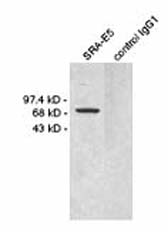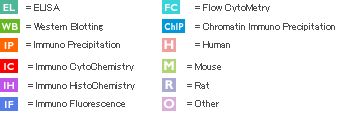
| Volume: | 50μg/200μL |
| Price: | inquiry |
| Antigen: | recombinant protein |
|---|---|
| GenBank ID: | 4481 |
| Immunizing animal: | mouse |
| Purification: | ProteinG |
| Antibody subclass: | IgG1 |
| Application | |
|---|---|
| Cross React | |
| Others | Macrophage scavenger receptor (MSR-A: CD204) was identified in the search for the receptor molecules that are implicated in the pathological deposition of cholesterol during atherogenesis through receptor-mediated uptake of modified low density lipoproteins (LDL). MSR-As possess a wide range of ligand-binding specificities and recognize a variety of molecules such as modified LDL including acetylated LDL, oxidized LDL, advanced glycation end products (AGE), polyribonucleotides such as poly G and poly I and bacterial surface lipids including lipopolysaccharide and lipoteicoic acid. This antidody was produced from the mouse immunized with recombinant protein of human type I MSR-A ,and has been proved to be useful for the immunoblotting and immunohistochemistry. This antibody is useful tools for the study of MSR in atherogenesis and various other pathological conditions in humans and animal species. |
| Reference |
|
| Collaborators | Dr. Takeya M., Second Department of Pathology, Kumamoto University School of Medicine, Kumamoto, Japan |
—
How to Order
Please contact one of following international distributors.
- Cosmo Bio USA, Inc.
- E-mail : info@cosmobiousa.com
TEL : +1-760-431-4600
FAX : +1-760-431-4600
- Funakoshi Corporation
- E-mail : reagent@funakoshi.co.jp
TEL : +81-3-5684-1620
FAX : +81-3-5684-1775
- FUJIFILM Wako Pure Chemical Corporation
- E-mail : ffwk-labchem-tec@fujifilm.com
TEL : 0120-052-099 (only in Japan)
FAX : 0120-052-806 (only in Japan)
- Sceti K.K.
- E-mail : export@sceti.co.jp
TEL : +81-3-5510-2652
FAX : +81-3-5510-0133


